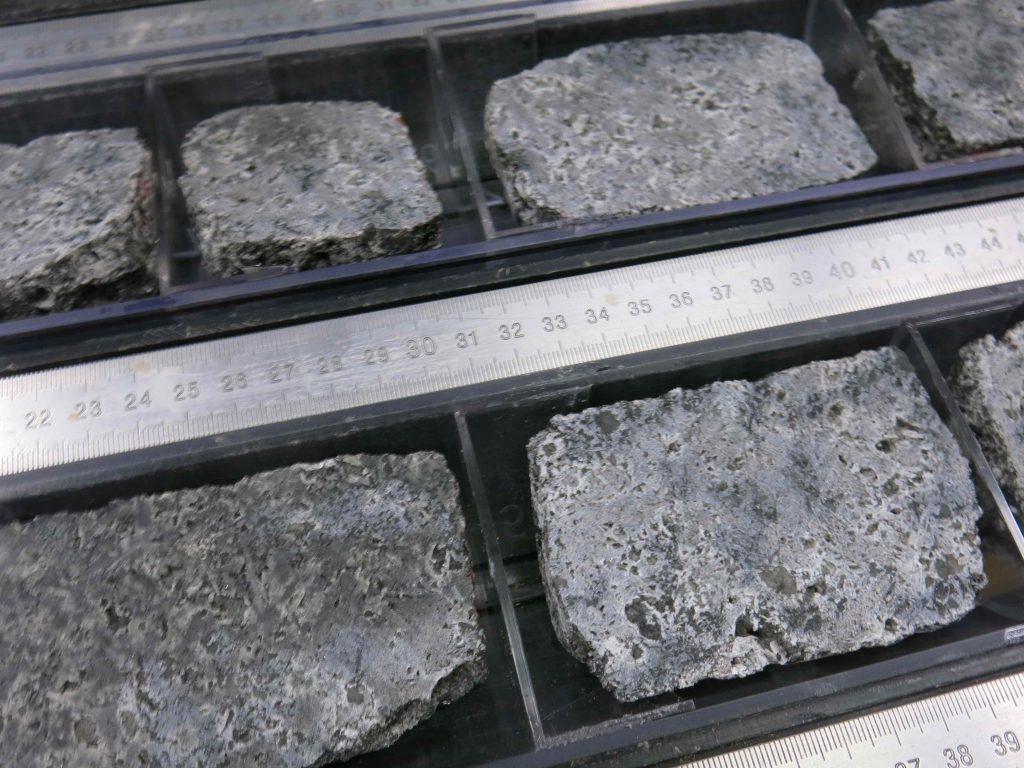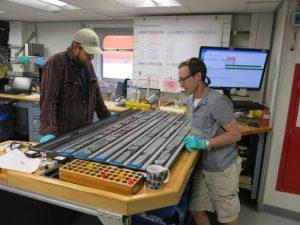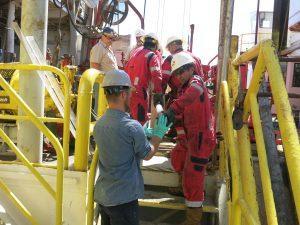
Breaking the Sills Curse, At Last
To recapture what has happened on this eventful day: All night and day, rocky cores have been arriving. They added up continuously, they began to wear out their welcome (although nobody would have admitted this), and they soon exceeded the predicted thickness of the sill. This is a theoretical and practical headache. Multichannel seismic analysis can predict the thickness of rock layers fairly accurately, as long as the speed of pressure waves propagating through the rock is known. This sill did not conform to prediction — it turned out to be much thicker than predicted, and here you see two experts, Florian and Dan, at the core table worrying why. This is not an academic question; the drill bit will last only 50 hours and then we will have to stop.

They stare and the rock stares back. Of course, this is fairly unusual dolerite, in patches almost porous as if filled with thousand small bubbles, which are coated with shiny crystals. Dan explains it with hydrothermal fluids circulating through cracks in the rock and gradually corroding the surrounding matrix, for example by washing out metals and sulfur that end up in “black smoker” hydrothermal fluid.
So, for MASC 401 students, here you have backstage access to the hydrothermal reaction zone that produces hot hydrothermal fluids, laced with all the chemicals (sulfide, hydrogen, methane, ferrous iron, etc.) that keep chemosynthetic hydrothermal microbes happy. But the science crew, perhaps not so much. Core after core arrives, and it is always rock! Here, technician Michael Bollen accepts a fresh core of rock, expertly drilled, while Dan is driven to distraction.

We are now thirty meters over prediction, and the phenomenal success in sill recovery begins to feel like this…

And unfortunately, the old Magician who would know how to stop the dolerite is out of town. The voice of reason keeps saying that at some point we must be through the dolerite. But conspiracy theories make their whispered appearance: We may have drilled into a deep magmatic conduit that connects multiple sills all the way down to the upper mantle; that would be a long drilling project indeed. Or, the ship has drifted off course and we are now drilling the sill of doom. As everybody knows, Wagner’s Flying Dutchman is in fact an IODP co-chief who dared to drill the deepest sill and is now condemned to sail forever…
But the spell falls apart all of a sudden in bright afternoon light. The 4 p.m. core contains no more sill but only a few crumbly bits. A deep sigh of relief! And the next core at 5:30 pm contains the carbonate cap that we have already seen on top of the sill. IT IS DONE. And we all may return to shore in due time.

To summarize, the sill is finally cored through, after more than 70 meters! The estimated/advertised thickness was half of what it turned out to be, an error of a similar magnitude as Columbus’ estimate for the Western sea voyage to India. Had anyone known that it would be this massive, we would not have dared to drill here. Drilling deeper and deeper was a gamble; what would give out sooner, the drill or the sill? For experts, this may be the most complete dolerite sill sequence ever recovered, with perfectly preserved contact zones on top and below. I recommend it as exhibit A for a future IODP museum…
After so much drama everyone need a soothing picture; here is a pod of dolphins having fun at the JR. There will be an animal story too, unfolding on the boat for days but finally ending well and therefore deemed fit for posting. Stay tuned!
This blog post first appeared on Oct. 12 on my daily blog of EXP385. Make sure to go to expedition385.wordpress.com to read the latest updates of this expedition!
Fantastic post!. Many thanks Andreas for taking us into this adventure through your beautiful post. I really laughed and were excited, concerned and finally supper happy of the final result. Congrats Expedition 385 science and crew team, AMAZING work.